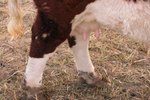A swollen lump on a goat's body may cause his owner to worry. While some lumps are benign and treatable, certain types are infectious and may spread disease to other goats and even humans if handled incorrectly. Concerned goat caretakers should contact their preferred veterinary professional, who can advise them on the best course of treatment.
Caseous Lymphadenitis
The disease caseous lymphadenitis begins as a lump under the goat's ear, or abscesses over the lymph nodes, head and shoulders. Some will appear behind the back of the jaw. The abscesses will grow and eventually rupture, contaminating the goat's living environment and soil for up to five months at a time. When left untreated, the abscesses can spread to the goat's internal organs, causing chronic wasting, according to the Myonic Goat Registry. If an abscess is detected, a veterinarian can develop a culture to determine if the bacteria is indeed caseous lymphadenitis. As the disease is highly contagious, individual goats diagnosed with it should be removed from the herd immediately. Their herd mates should be tested for the disease to prevent further spread. The veterinarian may recommend treatment measures including vaccination and diligent treatment of abscesses. The veterinarian also may be responsible for the culling of infected animals.
Cysts and Mange
Branchial cysts occur at the end of a goat's wattles. These fluid-filled swellings are a result of a development problem, and are difficult to remove surgically. Dermoid cysts are thought to be a developmental problem, and will often occur as a raised lump on the goat's skin that will increase over time. Dermoid cysts may be removed surgically for cosmetic reasons. Raised pustules on the goat's skin are often the result of mange mites living on the surface of the skin. The mites cause itching, and usually appear first on the lower legs, udders, scrotum and thighs of infected goats. Mange mites are most active in cold conditions, according to the University of Kentucky. Treatment measures include injections of ivermectin and property management, including disinfecting the goat's living space, burning bedding and storing hay separately from the goat's shelter.
Lumps on Faces and Necks
Goats will sometimes retain their cud, which results in the appearance of a lump on the animal's cheek. Cud retention is an indicator of sharp teeth, which interfere with a goat's ability to chew. A veterinarian can determine if a goat's mouth needs further attention. If a lump appears beneath the goat's jaw, it could be fluid retention brought on by a heavy burden of parasites. Called "bottle jaw," this condition is treatable by isolating the infected animal and immediately dosing him with a veterinarian-approved dewormer. Goiter, a large lump on a goat's neck, can occur in goats with a diet deficient in iodine. Goiter may interfere with the goat's ability to swallow. The veterinarian may recommend feeding iodized salt to correct the goiter, according to the website DVM 360.
Abscesses and Other Lumps
Although most can be avoided with good management, abscesses on goats can be caused by a wide array of bacteria. If an abscess is detected, the hair around the abscess will be removed and the lump will be aspirated with a needle to determine the type of bacteria, according to DVM 360. Once the culprit has been identified, the veterinarian can prescribe a treatment method. Tumors occur as solid masses on a goat's body. Unless they interfere with the goat's bodily functions, they are usually left alone, as no treatment measure has proven successful. Hematomas from blunt trauma appear suddenly as large raised areas on the goat's body, and usually resolve themselves over time without treatment. Hernias occur as a result of blunt trauma to the goat's abdomen, or may be the result of a genetic defect. These will appear as a large mass on the goat's abdomen, and can be corrected with surgery.
References
- Myotonic Goat Registry: Abscesses
- Biology Beyond the Lab: Common Swellings and Abscesses Found on Goats
- Farm Sanctuary: Goat Care
- Dawog: Abscesses and Lumps on Goats
- DVM 360: Common Questions From Goat Producers (Proceedings)
- Goatworld: Caseous Lymphadenitis
- University of Kentucky College of Agriculture: Bacterial Skin Diseases of the Goat
- ADM Alliance Nutrition: Goat Guide Health
Photo Credits
-
GlobalP/iStock/Getty Images





